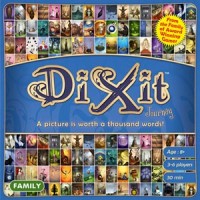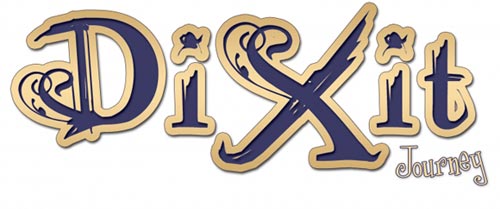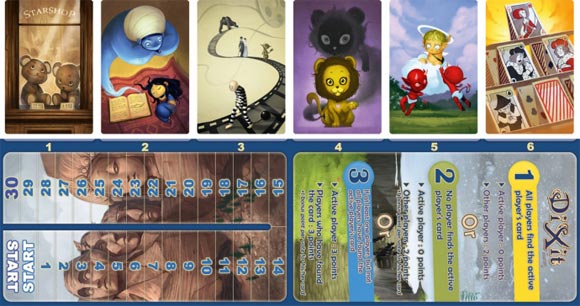
Dixit Journey

A new and enriched environment where the sky is the limit for creating truly enchanting scenarios.
Dixit Journey is a wonderful way to practice your skills at creating unique and subtle clues, while your friends test their abilities to bluff and mislead. A picture is truly worth a thousand words in this beautifully crafted board game that will be enjoyed by all.

In each round one person assumes the role of “active player” where they create a clue made up of one or more words or can even be a sound or group of sounds. The other players will then try to mislead everybody by finding a card in their hand that also represents the same clue.
Test your skills at correctly finding the solution to the clue…
Features
- High quality cards, board and game pieces.
- Game instructions that are clear and easy to understand.
- Artwork that inspires many creative clues and hours of enjoyment by everyone.
- For even more options in the game-play, mix in the cards from Dixit Odyssey or any of the other versions.
User Reviews (11)
Add a Review for "Dixit Journey"
You must be logged in to add a review.


We have 2 little girls (7 and 9 yrs old) that love to play games that we adults groan at. Ever tried “Beat the Parents”- don’t, just take my word for that one. “Eleminis,” “Pounce,” even “Story Cubes” and “Guess Who” are not my cup of tea. But I play them, because I love our girls and therefore I feel like I have to.
This game is totally different, I promise. I love this game. I love that the girls want to play this game and I love it when my partner wants to play this game too!
DiXit Journey is part story telling game part guess what everyone else is going to put down. It also has some amazing art on the cards that make you “oooh!” and “awwww!”
Object of the game is simple- get to 30 points first. The rules are spelled out at the top of the points board. There are only 3 rules (see picture above and slightly to the right).
My strategy changes when I am trying to guess my 7 year old’s description of “scary” (hint: it usually has a cat in the picture) vs my partner’s description of “A war of words.” On the 4th of July we played this with 6 people, ages ranging from 30s to my 2 little ones- and everyone had fun, laughed and truly enjoyed themselves!
I find that the pictures do not get old, as you can play the same cards with different results. For example you could easily play the lion card above (4th from the left) for a hand where the active player (the one who picks one card for everyone to guess) for the following phrases: “cat,” “ying and yang,” “dark side” and “bright eyes.”
The girls just guess what pictures they think best represents the phrase. For adults, I find it takes a little psychology, or knowledge of the person, to figure out what card s/he played. This game is a hit everytime. And everytime we play this game it is different. We love it!
The first time I played this with a group of 5 I thought, what the heck did I buy this for? It was really a bad game. After we played we ate some food and couldn’t stop talking about it. We played it all wrong.
The issue we had was we were trying to play at a competitive level. This isn’t that type of game.
This game is to create conversation and tell stories.
I play with my 5 year old, and it really helps him get creative (Yes I know, the game is for 8 and up- but I assure you it is still fun). This game is about getting creative and using your imagination, once you learn that the game becomes pretty fun.
This game art is awesome, and the rules are simple enough that you can include children (for entertainment purposes at least).
Playing this with my son is great, he can take a card and give it a back story. That is the point of this game.
When my 5 year old started to play he would describe the card exactly, such as “Two Knights fighting on a chess board floor”…there are not a lot of cards that depict that. Now he might take that same card and say “This is necessary for the kingdoms!” It opens up a lot more possibilities.
A house rule I have to play with an adult and child:
Shuffle the cards and flip the top one and tell a story. Flip the next card and continue the story, and keep going. The game isn’t meant to be played like that, but it is still fun.
Pros:
1 – Rules are easy to following
2 – Game play is typically around 30 minutes
3 – Art work is pretty sweet
4 – Builds creativity
5 – The more you play the more you will enjoy it and the better you will be at it
6 – Easy to teach
7 – The cards are over sized so it makes your hands feel small, I recommend wearing an oversized hat as well while playing
8 – No reading involved so children and older people that have problems reading cards can play
9 – I have yet to see any arguing from the players take place in this game (even if my dad really hard to spin us up)
10 – The game is not very competitive
Cons:
1 – First time playing I found to be pointless, I didn’t understand the concept of a “story telling” game
2 – This game is not very fun with fewer than 4 people; it says can play with 3 but that becomes lame very quick
3 – The more expansions added, the better the game is, this is a con because they are not cheap and I am not rich
4 – The point system is difficult to keep track of if you have 5-6 players (Dixit Odyssey fixed this with the new “voting” system)
5 – The game is not very competitive
6- If you play it with your dad he may act like an idiot in attempts to frustrate other players
I game mostly with my kids. They love Apples to Apples to the point that I want to get rid of the game. After seeing this game as an explorable game and in the store, I picked it up. This scratches a lot of the same kind of itch that Apples to Apples hits, but this does it in a better way. Apples is more simple, but Dixit really executes better.
Play is pretty basic (rules fit on one sheet of paper). The active player picks one of his or her cards and gives a clue for the card. The other players then pick one of their cards that fits. The cards are put together and the other players make guess (through numbered counters) which one is the active player’s card. If the active player gets all or none of the guesses, the other players get 2 points. If one or more, but not all of the other players guess the active player’s card, the active player and each correct guess gets 3 points. There are also bonus points for each of the other players who get a guess for their cards. First to 30 points wins. It’s that simple.
Apples has the non-active players throw in cards to match whatever whim the active player has, and there may be no rhyme or reason to that whim. Dixit instead urges the active player to give a clue that will describe the card so at least one player picks it, but not so obvious that all the other players pick it. The other players also can keep hold of the driver’s seat by giving a card that will try to steal the guesses.
This is a cool little game. It’s simple, it’s fun, and the art on the cards is really cool just to look at.
My Story
I found this game at a thrift store and I’m really pleased I did because I probably never would’ve tried it otherwise. I heard it described as “Like Apples to Apples, but with pictures,” and that immediately turned me off.
After having played it at game night, I have to say it is indeed like Apples to Apples. The main difference is that instead of one person choosing a winner seemingly at random, everyone chooses the winner by voting which card they think belongs to the “storyteller”. This makes all the difference and allows me to actually enjoy this game.
PROs
– Beautiful artwork
– Simple rules
– Encourages creativity
– Plays quickly
– Kids can play (or at least be on a team)
CONs
– Pictures can be too simple and too focused to come up with a good ambiguous clue.
– One play and we used almost every card already!
– My version came with cheap plastic pawns and the insert won’t hold any more cards (the newer printing had wooden bunnies and an insert that holds all the expansions up to this point)
Conclusion
Dixit is like Apples to Apples with pictures, but somehow it’s actually good.
They say a picture is worth a thousand words and that is so the case in DiXit, but, ultimately you want to use far fewer.
I had played DiXit when I bought Journey. The game play is the same, the challenges are the same, so why buy both? Simply put the additional cards and different artist make the game equally as entertaining.
I bought this version specifically to play with my students. I am a 7th grade teacher and their is great value educationally in this game. Students use inference, imagination and creativity to succeed at this game. And they have fun while doing it. Creativity is very challenging to teach directly. I cannot lecture on being creative. I can let them explore though.
The Rules
Everybody has 5 cards in their hand. The “Active” Player plays a card face down and gives a clue. The next players then have a chance to play a card, face down, that they think matches the description or clue. After a quick shuffle the Active Player lays out each of the cards played. The remaining players then vote (using voting tiles again face down) for the card they think the Active Player played. Scoring is based on voting. 3 points for voting for the Active Players card, 1 bonus point for each person who votes for your card. Exceptions are, if no one votes for the Active Players card everyone gets 2 points. Or if everyone votes for the Active Players card everyone gets two points. The Active player scores by having at least one but not all people voting for their card. (3 points) First to 30 points wins.
The Components of this game are great in a teaching setting too. The board having the basic point values for quick reference is invaluable. I was a little disappointed in the cheap plastic tokens. (Quite a step down from the wooden bunny tokens of DiXit.)
Pros
Encourages creativity
Beautiful Art
Many learning functions (Inference, summary, description, etc.)
Board has scoring reference
Easy to learn
Cons
Cheaper plastic tokens
Overall
A great game for everyone. I love it. I enjoy watching my students and son play the game and practice some wonderful storytelling skills. Great for adults too.
I’ve already reviewed Dixit and I gave it a lot of praise and this game gets the same amount of praise for its mechanics and great artwork but the only thing really missing physically is the the bunnies. That’s really the only thing that makes this game different. We are just using standard player tokens. But other than that, it really is the same game but without bunny meeples and also the artwork is different.
I have both Dixit and Dixit Journey and I don’t think as a game one is better than the other. However, I think it is completely necessary to buy Dixit Journey even if you have Dixit especially if you have played Dixit too many times with the same group which I have. If you keep on drawing the same cards over and over, your friends will know what you will always use as your hint to match up with your card so having another set of cards from Dixit Journey really gives it that variation and freshness.
I really love Dixit. I love the creativity aspect of it and I love that it also has a psychological aspect to it in the sense that you are trying to figure out how the other players think. So as as long they keep on making expansions, I’m going to keep on buying them to keep the game fresh.
Overview: Dixit Journey is a party game in which 3 to 6 players use creativity and psychology to communicate through intricately illustrated cards. This can be used as a stand-alone game or combined with another Dixit set for expanded card options.
Gameplay: Each player receives a hand of cards portraying a myriad of full-color illustrations. They contain many fairy tale and storybook inspiring images with many details. Players take turns being the “Storyteller”. They select a card, placing it face down on the table, and say a word or phrase about it. The other players add a card from their hand that they feel matches the phrase as a “bluff”. All the cards are shuffled and placed face up on the table. Everyone votes on which card they think was the Storyteller’s.
Players receive points by choosing the original image and by having their bluff image selected. The Storyteller scores by having some, but not all, players select his image. This dynamic is what creates the psychology of the game. The Storyteller needs to use his knowledge of the other players to choose phrases and images which will only be correctly translated by at least one, thus keeping him from being too obvious and too vague simultaneously.
Everyone takes a few turns as the Storyteller until the draw deck is depleted, which typically takes less than an hour. The player with the highest score wins.
Pros:
– The included game board is a large improvement over the original, with numbers to identify played cards and the rules for scoring boldly printed on it.
– The rules are short and easy to learn, making this accessible to all ages and perfect for casual gatherings.
– Can be combined with original to expand the previously limited pool of cards.
Cons:
– The relatively small pool of cards can limit the replay value of the game involving the same group of players.
– The artwork is not as ambiguous and themes do not crossover as much as in original set, creating more of a challenge for Storytellers.
Historical Figure/ Fictional Character I’d Most Like to Play Against: Sigmund Freud
Dixit will challenge your imagination as you strive to understand your opponents’. It provides fast, lighthearted fun which can be added to almost any occasion. This should be anyone’s first Dixit purchase.
Dixit is a stand alone sequel to the original Dixit and plays exactly the same way. For those of you who aren’t familiar with Dixit and how it plays, check out my review of the original Dixit on my home page.
So if Dixit Original and Dixit Journey play exactly the same, why buy this one instead of, or in addition to the original? Well for one thing they each come with a completely different set of cards. Neither one is necessarily better than the other, but when they are mixed together, it adds more variety to the game, which does add replay value.
Unlike Dixit Original, whose board basically is the bottom half of the box, Dixit Journey comes with a folding board separate from the box. The Dixit Journey board is more practical in that it takes less space and features the numbers 1-6 on one side to place the cards in front of so you know which card is which number. The only downside to this board is that instead of being very colorful like the original, it is quite plain looking, featuring only a picture of a Mount-Rushmoor-like painting.
Also unlike the original, Dixit Journey comes with plain plastic pawns for the players instead of the wooden bunnies. This was entirely unacceptable to me and that is why whenever my group and I play with Dixit Journey, we always mix it with the original so the can have the benefits of both the Journey board and the original pawns.
Overall, I don’t believe Dixit Journey is as good of a buy as the original, solely because of the pawns and so I would recommend buying the original first, then Dixit Quest, then Dixit Odyssey, then Dixit Journey.
Dixit has it moments. It can potentially be a very fun game and it can also be a little unexciting. That all depends on the people you play with. Imagination is key and understanding the opponents psyche is important. Ultimately, its a race to the finish. The key of the game is trying to get at least one other opponent to guess your card correctly. It cant be too obvious and it also cant be too difficult. During your turn, you must try to give a clue that only one other person knows. That way, you can score your points to move your bunny ahead.
All in all, it is fun game. It can also be fun to play with non-gamers I think. Or at least try to introduce them into the games. PLaying with children is also good. I rarely get to play these nowadays, mostly because my friends want to play something else. Still, a good game. Good artwork. Nice big cards.
In Dixit, you have a hand of 6 cards with nicely done art work on them. One person picks one of their cards and says something that makes them think of their card. This can be a phrase, lyric, one word, whatever comes to mind. Everyone else takes a card from their own hand that they think matches the phrase, lyric, or whatever was said. The cards are randomly laid out and people bid on which card they think was the one chosen by the person who started that turn. Points are scored (not going into every rule here) and play is passed. I have played with ages 5 to 65 so far and believe it or not, younger folk are not at a disadvantage. I love this game, cards are great quality , art is great, and play is mellow and very entertaining. Dixit has a few different sets out, which I believe (can anyone confirm?) just have different art on the cards but plays the same. Either way I want to own them just to mix it up. Hope this helped some, and happy game playing.
what brings me back to this game over and over is the artwork of each card. every time you give description of a card it takes on a different interpretation. the more you play the deeper it can get. i would really try and look at each card and see how in depth they are. you will be surprised what whats in each card. the speed of the game is so so. it can be fast paced or it can drag if you don’t have a timer on the decision making process. once you can get pass that, the game flows well. give it a try and i hope you have as much fun as we have with it!